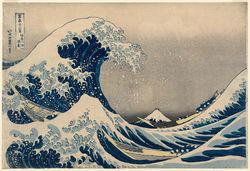Difference between revisions of "Category:Gamboge: Ukiyo-e colorant"
| Line 2: | Line 2: | ||
[[File:SC130566.jpg|right|250px|link=https://collections.mfa.org/objects/234428/under-the-wave-off-kanagawa-kanagawaoki-namiura-also-kn?ctx=ed6b9b8b-e830-4c25-9793-ba7646059146&idx=3|Great Wave by Katsushika Hokusai]] | [[File:SC130566.jpg|right|250px|link=https://collections.mfa.org/objects/234428/under-the-wave-off-kanagawa-kanagawaoki-namiura-also-kn?ctx=ed6b9b8b-e830-4c25-9793-ba7646059146&idx=3|Great Wave by Katsushika Hokusai]] | ||
| − | <font size="3">'''[[Gamboge]]'''</font> 藤黄(''to-o''): A yellow-orange gum-resin produced by several species of ''Garcinia'' tree found in India, Thailand, Cambodia, Vietnam, and Ceylon. Gamboge was used as a yellow pigment as early as the 8th century in Asia and Japan. Gamboge is composed of a yellow resinous component (70-80%; morelloflavone) and a clear water-soluble [[gum]] (20%). Gamboge | + | <font size="3">'''[[Gamboge]]'''</font> 藤黄(''to-o''): A yellow-orange gum-resin produced by several species of ''Garcinia'' tree found in India, Thailand, Cambodia, Vietnam, and Ceylon. Gamboge was used as a yellow pigment as early as the 8th century in Asia and Japan. Gamboge is composed of a yellow resinous component (70-80%; morelloflavone) and a clear water-soluble [[gum]] (20%). |
| + | |||
| + | Gamboge has not yet been detected as a single colorant but has been found in mixtures with other yellows. | ||
'''For more information see:''' [[Gamboge]] | '''For more information see:''' [[Gamboge]] | ||
Revision as of 18:25, 15 May 2020
Gamboge 藤黄(to-o): A yellow-orange gum-resin produced by several species of Garcinia tree found in India, Thailand, Cambodia, Vietnam, and Ceylon. Gamboge was used as a yellow pigment as early as the 8th century in Asia and Japan. Gamboge is composed of a yellow resinous component (70-80%; morelloflavone) and a clear water-soluble Gum (20%).
Gamboge has not yet been detected as a single colorant but has been found in mixtures with other yellows.
For more information see: Gamboge
Examples of Gamboge in Ukiyo-e Prints

|

|

|

|

|
Analysis
Gamboge does not fluoresce under UVA radiation and does not produce a distinct pattern using Excitation Emission Matrix spectroscopy (EEM). As it is the only bright yellow colorant that does not fluoresce (of those analyzed) but also absorbs UVA induced fluorescence emitted by the paper, this negative indication was sometimes used to assign the presence of gamboge.
Other Images of Gamboge
List of Prints
List of prints where indigo was detected
Pages in category "Gamboge: Ukiyo-e colorant"
The following 12 pages are in this category, out of 12 total.
G
K
- Kiyomasu I, Courtesan Reading a Poem, 28.198
- Kiyomasu II, Actor Ogino Izaburô I as Yamagami Gennai, Acting in the Aragoto Style with the Sumikazura Wig, 11.13297
- Kiyomasu II, Actors Segawa Kikunojô I as Yomogiu, Ichikawa Ebizô II as Tono no Hyôe, and Yamamoto Kyôzô as Kureha, 21.5459
- Komatsuken, Courtesan Parading with Two Kamuro, 11.19711
- Komatsuken, Young Man as the Bodhisattva Monju, 11.30137
- Komatsuken, Young Woman as the Bodhisattva Fugen, 11.30136







